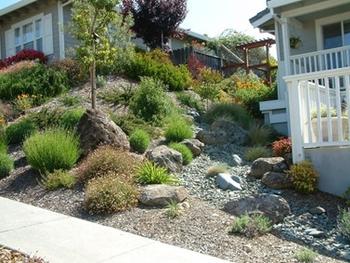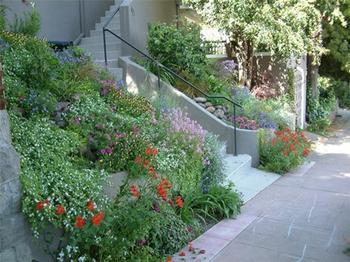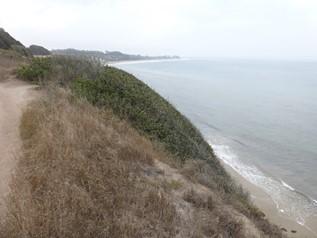When gardening is a slippery slope

The chief concern with gardening on hillsides is erosion – that is, the washing away of topsoil. Wind and water are the primary causes of erosion, especially when delivered in extremes. Intermittent showers are lovely; prolonged downpours can cause trouble. It’s like exfoliating your skin: a little is okay, but you don’t want to peel off the top layer of your face. Similarly, you don’t want your hillside sliding into your house or your neighbor’s. To keep your slope intact, safe, nice-looking, and maybe even traversable, you have some choices and decisions.
How will you use the space?
Start by deciding how you want to use your slope. Do you want to walk on it or simply spruce it up? This is a critical decision, because if your slope is simply for viewing, there’s probably a lot you can do with plants alone. If, on the other hand, you want to walk on your hillside (instead of putting a deck over it), then you’ll need to decide how to safely negotiate that steepness without taking a nasty fall. Your beautifully planted hill isn’t going to look so great if you’re sliding down it feet first. Notching in steps here and there or plunking down stone pavers is one solution, albeit somewhat dangerous. But what if you want a more permanent and cohesive solution?

The answer is terracing, which turns a hillside into a series of flat areas. Using stones, boulders, wood, concrete, or other hardscape material, terracing is an excellent way to prevent water runoff and create planting areas. By building retaining walls and leveling off garden spaces, rainfall seeps into the soil instead of running downhill and causing erosion problems. It allows for steps and paths for walking and rolling wheelbarrows. Like houses, terracing can appear formal or rustic, naturalistic or modern, whatever your aesthetics and checkbook desire.
Regardless of the look you’re after, you’re best off tackling your slope with a landscape contractor – especially if it’s steep. Why? Because doing it yourself is challenging and not without risk. The weight and pressure of soil against terracing material is significant. Best to leave it to a professional. Safe, effective, and attractive terracing requires specialized skill and experience.
Plants help keep soil from sliding on hillsides
If you simply want to spiff up your hillside, choose a mixture of deep and shallow-rooted California native plants to hold soil in place. These include many species of manzanita, ceanothus, buckwheat, sage, coyote brush, coffeeberry, and artemisia, among others. Low-water, deep-rooted plants from other Mediterranean climates are also helpful.

California’s shrubs and perennials provide a rugged, inexpensive, and effective solution to managing slopes. But before you start planting, be sure you understand how water flows on your property so that you can alter its course if necessary or possible. Using berms and swales (or pipes), create contours that transport water where you need it – or away from areas where you don’t want it. Current regulations require that we keep as much water on-site as possible, so find ways for water to sink in rather than run off.
Set your irrigation timer for shorter but more frequent drip-watering cycles, especially if your hillside is particularly steep. This allows water to seep deeply into the soil where the roots are instead of running off.
Learn more about hillside gardening.
